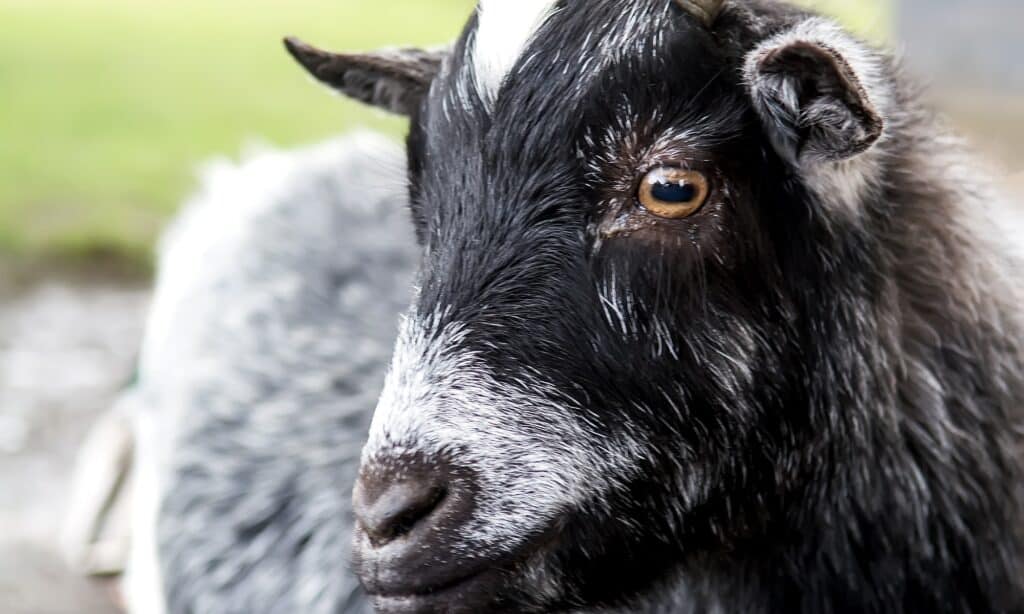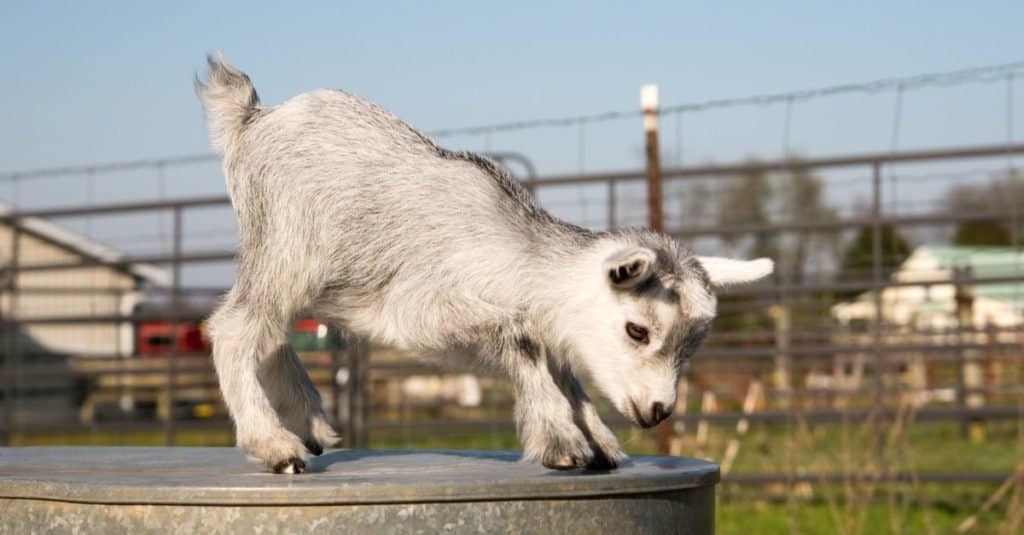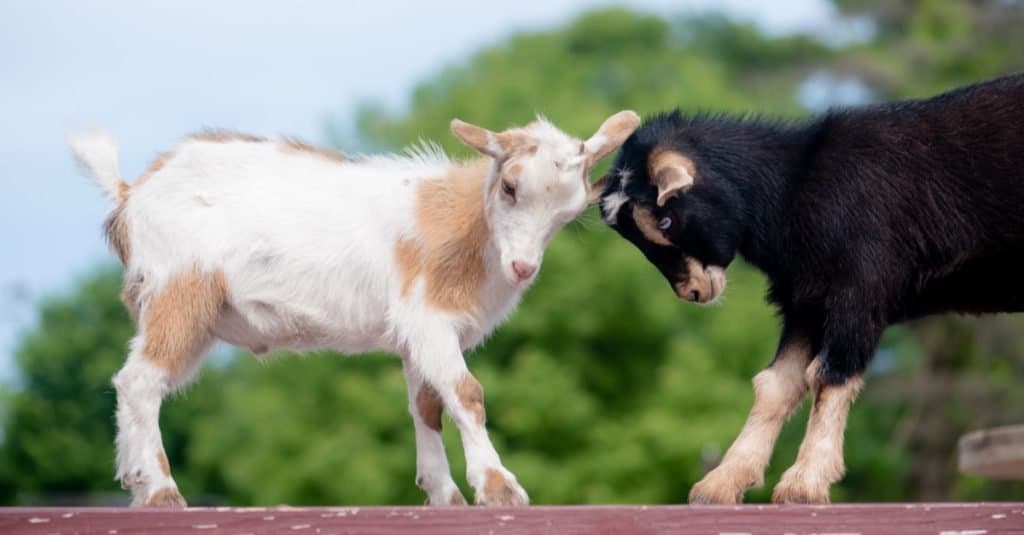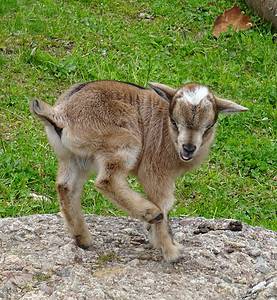Have you ever seen a goat faint? If you like to browse the internet, chances are you’ve seen a video of startled goats keeling over with their legs high in the air. While it’s good for a laugh, this breed of goat has a real medical condition that makes them appear to faint from fright. The trigger can be something as innocuous as a human joking around or as serious as an attacking predator. Read on to find out all about this breed and its bizarre condition!

Fainting goats have a genetic condition, myotonic congenita, that makes them appear to faint.
©iStock.com/alisa24
What is a Fainting Goat?
Fainting goats are a breed of goat within the genus Capra in the family Bovidae. They suffer from a genetic condition called myotonic congenita. This makes them appear to faint when frightened or startled. Despite this unusual malady, fainting goats look much like any other kind of goat.
Other names for fainting goats include:
- Myotonic goat
- Tennessee fainting goat
- Tennessee wooden-leg goat
- Falling goat
- Stiff-legged goat
- Nervous goat
The breed developed in Tennessee in the 1880s after a farmer brought over a buck and 3 does. It’s entirely possible that all fainting goats in the United States came from these four individuals. There’s no consensus on their origin prior to this.
Do Fainting Goats Actually Faint?
Contrary to their name, fainting goats don’t actually faint. The genetic condition myotonia congenita causes an extension of the muscle contraction commonly known as the “fight-or-flight” response. Normally, this response involves momentary muscle tension in response to frightening or startling stimuli. Then the muscles relax to allow the animal to either defend itself or flee. However, animals with myotonia congenita experience prolonged muscle contraction, sometimes for as long as 10-20 seconds.
Because this response lasts so long, affected goats usually find themselves unable to stay on their feet. They topple over on their sides or backs where they remain until their muscles relax again. They are conscious the whole time and experience no pain.
Why Do Fainting Goats “Faint”?
Fainting goats “faint” for a couple of different reasons. Most commonly, something in their environment startles them. Potential culprits include predators, loud noises, other goats, or even themselves. Of course, human owners often scare their goats for a laugh with their cameras at the ready. Despite the concerns of animal rights activists, myotonia congenita causes no pain to the animal, nor does it have lasting effects. Goats usually pick themselves back up within 5-10 seconds and continue on their way.
However, goats don’t have to be startled to freeze up. Excitement can be just as effective as fear. Many owners have observed their goats collapse during feeding time or even while being petted. Some goats also “faint” while trying to escape from their enclosures. In short, just about anything new, thrilling, or unexpected can cause one of these goats to end up on the ground.
Interestingly, some older goats can learn not to fall when their muscles tense up. With experience and practice, many are able to stay on their feet until the contraction passes.

Fainting goats don’t actually faint or lose consciousness. Their muscles contract and freeze for several seconds, which causes them to fall over.
©jctabb/Shutterstock.com
Why Do People Breed Fainting Goats?
People breed fainting goats for a number of reasons. Firstly, their muscular bodies make them excellent meat goats. In this regard, the constant “fainting” actually helps! Myotonia causes frequent muscle tension, which in turn bulks up the muscles. Because of this, fainting goats have more muscle mass and less body fat than most other breeds.
Secondly, they make good pets. Some people keep them as novelties because they just like to see them faint. However, these goats also have pleasant dispositions and are visually appealing. An added benefit is that they usually don’t try to escape their enclosures as it can lead to “fainting spells.”
Thirdly, livestock owners sometimes kept fainting goats to protect their other livestock. When predators attack, the rest of the animals run while fainting goats keel over. The predators then focus on the easy kill, allowing the more valuable animals to get away. This is no longer a common practice today.
Is There a Cure for Myotonia Congenita in Goats?
At present, there is no cure for myotonia congenita in goats. Lack of water appears to improve their condition, though this is obviously not a solution to the problem. Scientists are able to use fainting goats to conduct research into myotonia congenita in other species, including humans.
Appearance and Size
Fainting goats come in a wide range of colours and patterns. The most common is a mixture of black and white. Other colours include grey, tan, brown, red, blue, gold, and cream. Coats can be tri-coloured, quad-coloured, or spotted against a solid background. Fainting goats come in both long-haired and short-haired types. Their eyes are large with a distinctive bulge.
Fainting goats are among the smallest of the goat breeds. Adults stand between 17-25 inches tall and weigh anywhere from 50-175 pounds, making them potentially as small as a Nigerian Dwarf goat. They have abundant musculature.
Diet and Predators
Like other breeds of goats, fainting goats are herbivorous ruminants. They thrive on a typical goat diet including hay, grains, and grasses. They also enjoy plant matter like leaves, stems, flowers, weeds, bark, shrubs, and bushes. Salts from mineral deposits are important supplements. Due to their intricate digestive systems, these goats spend much of their time imbibing, chewing, and digesting their food.
Because of its condition, this breed is especially susceptible to attacks from predators. Owners must guard against the likes of coyotes, wolves, foxes, bobcats, mountain lions, and bears. Large birds of prey like eagles may also attack goat kids.

Fainting goats come in a wide variety of colours and patterns, much like these Nigerian goats.
©Debra Anderson/Shutterstock.com
Reproduction and Lifespan
Male fainting goats often reach sexual maturity by 4 months of age, though it’s advisable to wait until they reach one year of age to breed them. Livestock owners should not breed their female goats until they reach 12-18 months of age. Females enter estrous (heat) every 21 days.
Fainting goats usually breed from late August to early January, but some are able to breed at other times of the year. Males signal their readiness to mate by releasing a foul-smelling odour from their sex glands. Females wag their tails, vocalize, and release mucous.
Pregnancy lasts about 150 days, after which the female gives birth to 1-3 kids. Fainting goats often have twins or triplets. The mother weans the kids by 8-12 weeks of age.
Fainting goats typically live between 12-15 years.
Are Fainting Goats Endangered?
The Livestock Conservancy classifies fainting goats as “recovering.” This breed can’t naturally survive on its own, as the goats immediately fall down whenever frightened by a predator. In the wild, they would soon be wiped out. Because of this, it falls to humans to keep the breed alive. There are approximately 10,000 fainting goats in the world today.
Whether they’re bred for meat, companionship, or just for fun, there’s no doubt: fainting goats are one of the most unique breeds on the planet!
The photo featured at the top of this post is © Georgia Evans/Shutterstock.com
Thank you for reading! Have some feedback for us? Contact the AZ Animals editorial team.







